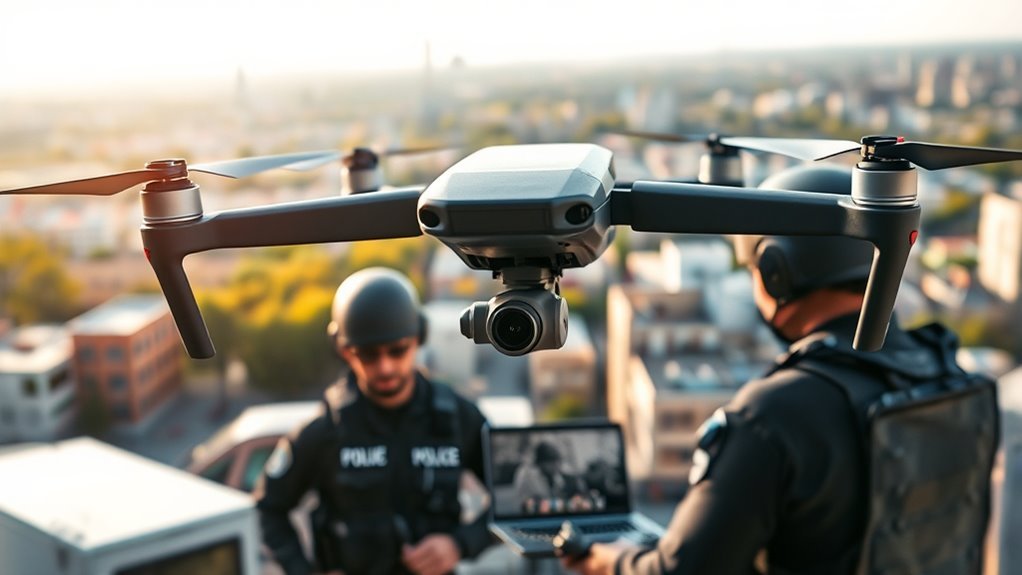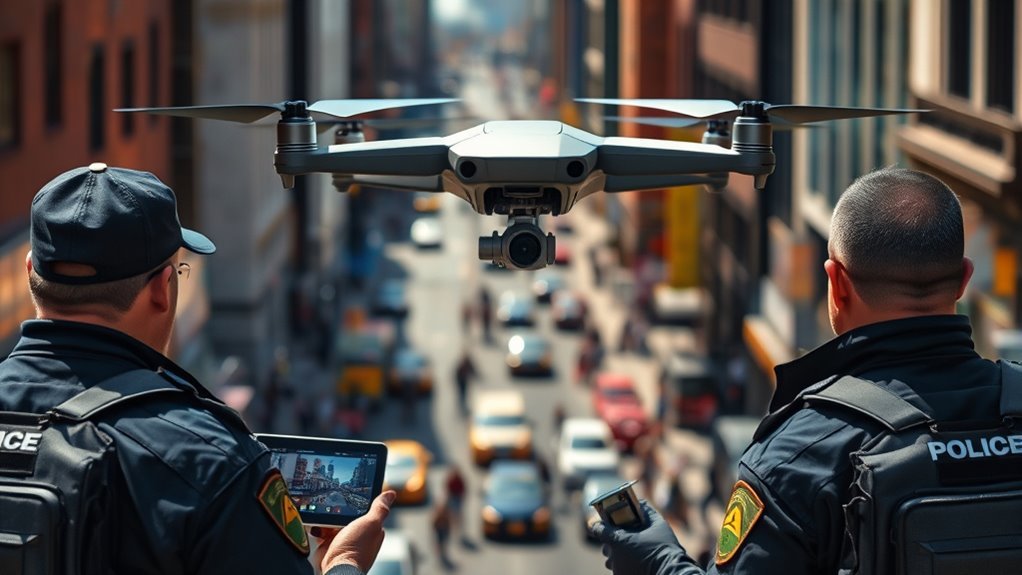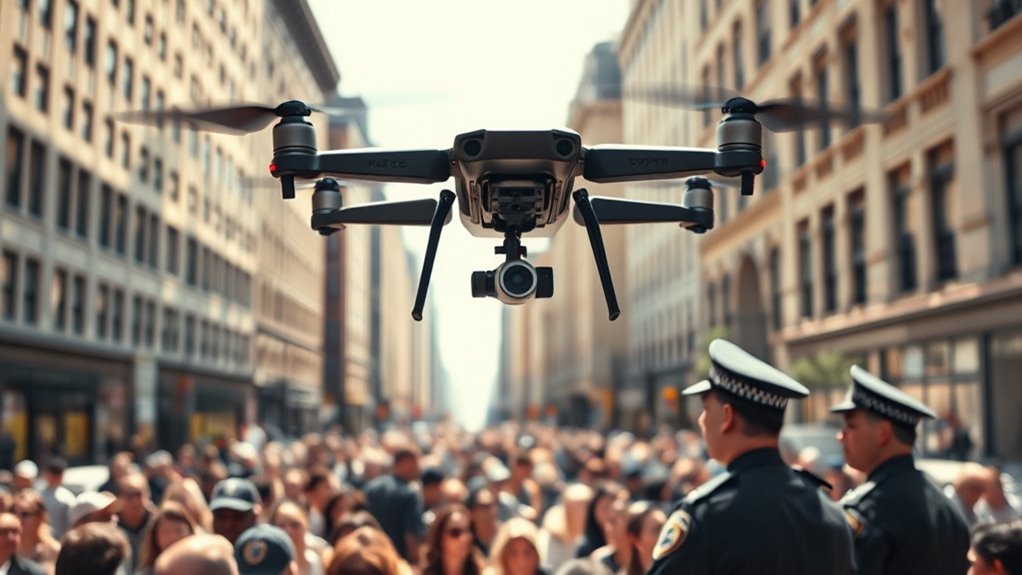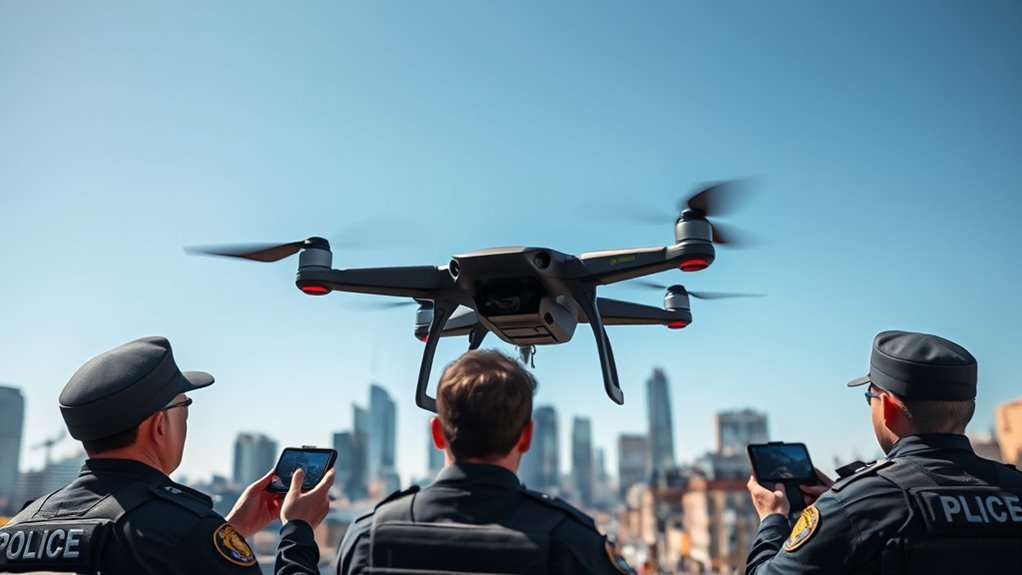Drones greatly enhance modern police operations by offering advanced surveillance, real-time monitoring, and improved search and rescue capabilities. Equipped with high-resolution cameras and thermal imaging, they aid in evidence collection and provide vital situational awareness. However, these advancements also raise privacy and ethical concerns, particularly regarding data collection and community trust. Balancing public safety with individual rights is essential, and there’s much more to explore about how this technology is shaping law enforcement’s future.
Overview of Drone Technology in Law Enforcement

As law enforcement agencies increasingly turn to innovative solutions, drones have emerged as a vital tool in modern policing. You’ll find that drone advancements have greatly transformed operational capabilities, allowing for enhanced situational awareness and rapid response. The integration of advanced technology, such as high-resolution cameras and thermal imaging, facilitates real-time monitoring and data collection. This integration not only improves efficiency but also raises important questions about privacy and civil liberties. Additionally, drones like the Draganfly Commander 2 offer sophisticated safety features, enhancing operational reliability in critical situations. As you analyze the implications, it’s essential to reflect on how these tools can balance public safety with the desire for freedom. The evolving landscape of drone technology presents both opportunities and challenges, urging law enforcement to adopt responsible practices while adapting to the demands of contemporary society. Notably, drones equipped with thermal imaging technology can significantly enhance search and rescue operations, providing critical information in low-visibility conditions.
Enhancing Surveillance Capabilities

While many traditional surveillance methods have limitations, drones greatly enhance surveillance capabilities in law enforcement. Their aerial perspective allows for real-time monitoring of vast areas, enabling officers to gather critical intelligence without the constraints of ground-based methods. Utilizing advanced drone capabilities, police can optimize surveillance efforts, tracking suspects or evaluating situations from a safe distance. This not only improves the efficiency of operations but also minimizes risks to personnel and the public. In addition, the integration of thermal imaging and high-definition cameras enhances data collection, providing clearer insights into criminal activities. By embracing these technologies, law enforcement can adapt to modern challenges, ensuring that citizens’ freedoms are respected while maintaining public safety. Furthermore, the choice between drones can significantly impact the effectiveness of surveillance based on specific operational needs. For instance, utilizing drones like the EHang EH216-S can offer advanced monitoring features such as high-resolution cameras and AI-driven processing for reliable performance.
Crowd Monitoring and Event Management

When it comes to crowd monitoring and event management, drones provide significant advantages in enhancing situational awareness. By offering real-time aerial views, they help law enforcement assess crowd dynamics and identify potential issues more effectively. This capability can lead to quicker response coordination, ensuring public safety during large gatherings.
Enhanced Situational Awareness
Drones have transformed the way law enforcement agencies approach crowd monitoring and event management, enabling them to gather real-time data from above. This enhanced situational awareness greatly improves decision-making during public gatherings. Here are some key benefits of using drones in this scenario:
- Real-time monitoring of crowd dynamics allows for immediate assessments.
- Improved visibility helps identify potential risks or disturbances before they escalate.
- Data collection can inform law enforcement strategies, ensuring a more effective response.
- Resource allocation is optimized, directing personnel where they’re needed most.
Rapid Response Coordination
As crowd dynamics shift rapidly during large events, the ability to coordinate a swift response becomes essential for law enforcement. Drones play a pivotal role in this process, enhancing emergency response through real-time aerial surveillance. By providing live feeds, they enable officers to assess crowd behavior, identify potential threats, and streamline tactical coordination among units. This technology allows for a proactive approach, helping prevent situations from escalating into chaos. Additionally, drones can efficiently monitor large areas, ensuring that resources are deployed where they’re needed most. As public events grow in scale, the integration of drones in crowd management not only enhances safety but also respects individual freedoms by maintaining a balance between security and civil liberties.
Search and Rescue Operations
Although traditional search and rescue operations often rely on manpower and ground-based equipment, the integration of drones has greatly transformed these efforts. Drones enhance rescue missions by providing real-time aerial views and improving efficiency. Here’s how drone deployment is shaping search and rescue operations:
- Rapid Area Coverage: Drones can quickly scan vast areas, locating missing persons faster than ground teams. Their superior flight performance allows for swift and efficient searches across challenging terrains.
- Thermal Imaging: Equipped with thermal cameras, drones can detect body heat, aiding in nighttime or dense vegetation searches.
- Communication Relay: Drones can serve as mobile communication hubs, connecting teams in remote locations.
- Safety Enhancement: They reduce the risk to rescuers by surveying hazardous terrains before ground crews enter. Additionally, drones equipped with advanced sensor technology can continuously monitor their surroundings, further ensuring safety during operations.
These advancements empower freedom of movement and notably enhance the effectiveness of rescue missions.
Evidence Collection and Crime Scene Analysis
When it comes to evidence collection and crime scene analysis, drones offer significant advantages like aerial photography that captures detailed imagery from unique perspectives. This technology enables law enforcement to gather real-time data, enhancing their ability to assess scenes quickly and accurately. As you explore the implications of these advancements, consider how they reshape traditional investigative methods.
Aerial Photography Benefits
Drones equipped with high-resolution cameras have transformed the landscape of evidence collection and crime scene analysis. The use of aerial imaging and drone photography has provided significant advantages for law enforcement. Here are four key benefits:
- Comprehensive Views: Drones capture expansive areas, offering a perspective that ground-level photography can’t achieve.
- Documenting Evidence: High-resolution imagery guarantees all details are recorded, aiding in the preservation of crime scene integrity.
- Time Efficiency: Drones can quickly cover large areas, reducing the time needed for initial assessments.
- Safety: By using drones, officers can gather information without putting themselves in potentially dangerous situations.
These benefits not only enhance investigative processes but also uphold the principles of effective and responsible policing.
Real-Time Data Analysis
As law enforcement agencies increasingly adopt drones for evidence collection, the integration of real-time data analysis is becoming essential. This technology allows officers to conduct real-time tracking of incidents and gather significant information on crime scenes. By utilizing drones equipped with advanced sensors, agencies can collect data that integrates seamlessly into existing systems, enhancing situational awareness. Real-time data empowers law enforcement to respond more effectively to ongoing incidents, making informed decisions based on current information rather than delayed reports. Furthermore, this capability can improve evidence collection, ensuring that important details aren’t overlooked. As you consider the implications of drone technology, it’s imperative to weigh the benefits of efficiency against potential privacy concerns in your community.
Privacy Concerns and Ethical Considerations
While law enforcement agencies increasingly turn to drones for surveillance and operational support, the rise of this technology raises significant privacy concerns and ethical dilemmas. You might find it essential to contemplate several key issues:
- Data Privacy: How is personal data collected and stored?
- Consent Issues: Are individuals aware their privacy might be compromised?
- Accountability Measures: What systems are in place to prevent misuse?
- Regulatory Frameworks: Are there laws ensuring transparency practices and protecting public trust?
As you reflect on these points, ponder the ethical implications of drone use in policing. The potential for community backlash and surveillance ethics is real, making it imperative to balance safety with individual rights.
Community Engagement and Public Perception
Community engagement plays an essential role in shaping public perception of drone use in policing. When police departments actively participate in public outreach, they foster community trust, which is vital for effective policing. Transparent communication about drone capabilities and limitations can alleviate fears and misconceptions. Engaging with citizens allows law enforcement to hear concerns, address them, and adjust their drone usage policies accordingly. This approach not only builds trust but also empowers communities to feel involved in the decision-making process. However, neglecting community input can lead to skepticism and resistance. Ultimately, a collaborative relationship between police and the community can enhance the effectiveness of drones, ensuring they serve public safety without infringing on individual freedoms.
Frequently Asked Questions
How Are Drones Operated by Police Officers?
As eyes in the sky, drones operate through advanced drone technology, allowing officers to conduct aerial surveillance. You’ll find them maneuvering with precision, gathering essential information while steering through complex environments to guarantee public safety and security.
What Types of Drones Are Commonly Used by Law Enforcement?
You’ll find that surveillance drones are often used for monitoring large areas, while tactical drones assist in active situations. Both types enhance situational awareness, but they also raise concerns about privacy and civil liberties.
Are Drones Equipped With Weapons for Police Use?
You might wonder if law enforcement employs armed drones. While some agencies explore this option, ethical concerns and regulations often limit their deployment, highlighting the ongoing debate about balancing public safety and individual freedoms.
How Are Drone Operators Trained in Police Departments?
In police departments, drone operators undergo rigorous training, focusing on drone certification and operational protocols. This guarantees they can effectively and responsibly utilize drones while respecting citizens’ rights, maintaining transparency, and promoting accountability in law enforcement practices.
What Regulations Govern Police Drone Usage?
When you consider police drone usage, it’s essential to understand regulations tied to privacy concerns and legal frameworks. These laws aim to balance public safety with individual freedoms, ensuring accountability in surveillance practices.

